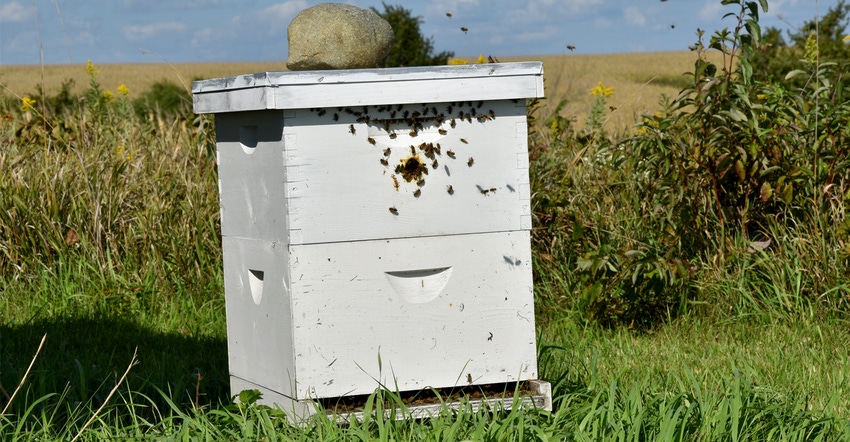June 11, 2020

Honeybees bring a lot to the table — and not just honey. The insects can be raised for a hobby or for commercial production. No matter the reason, bees are known for their important role in many agricultural systems. Talk to any beekeeper about their bees, and they’ll be quick to tell you how necessary these little creatures are and how much they admire them.
“If we didn’t have honeybees, one third of all the food you eat would disappear,” says Donna Brahms, president of the Southwest Iowa Beekeepers. Brahms began raising bees in 1993 and has helpful advice for those interested in doing the same.
Honey as a hobby
“The first thing I would recommend is take a beekeeping class,” Brahms says. “Then I would look into local beekeeping groups. Then be active and learn all along — you’ve always got somebody who can help you out.”
Brahms served as the Iowa Honey Producers Association president for many years and has since stepped back to produce honey for farmers markets. Brahms also uses her bees to pollinate many acres of vegetables and apple trees on her family farm.
After initially purchasing bees, it is necessary to buy the hives they live in. Other equipment needed is beekeeping protective wear like veils, gloves or even bee suits. Tools such as smokers and hive tools are also used.
Bees make honey by adding enzymes to the nectar they collect from plants. They fill the frames in the hive with honey and will produce a wax to cap off the liquid. “When you see those white wax caps on the honey, that means it is able to be collected out of the hive,” Brahms says. “You have to melt those caps off with a scratching tool or a hot knife. Then you run the frame through an extractor, which uses centripetal force and forces the honey out.”
Once the honey is out of the frames, it can be drained to remove any unwanted materials such as bee parts. It can be poured into containers, and producers can sell it or keep it for their own use.
Commercial production
Beekeeping can go beyond small-time honey production. Phil Ebert owns Ebert Honey, a company commercially selling honey, beeswax and the bees themselves. Ebert is also involved in migratory beekeeping.
“We send our bees to California for almond pollination,” he says. “I think there are 2.3 [million] to 2.4 million colonies of bees in the United States, and somewhere around 1.8 [million] to 1.9 million of them go to California for almond pollination.”
According to Brahms, crops like almonds, blueberries and cranberries rely on honeybees for pollination, and more producers are sending their bees across the country to help with the pollination effort. It is more common for commercial beekeepers to contract bees compared to hobbyists.
Ebert says whether keeping bees as a hobby or on a larger scale of production, the biggest challenge beekeepers face is keeping their colonies alive and healthy.
Parasites and pesticide drift
“We have to control the parasite load,” Ebert says. “We have Varroa mites which originated on an Asian bee and now have spread worldwide. It has upset the apple cart, so to speak.”
Varroa mites are parasites that can live externally on adult bees and also feed on the developing brood. Brood are honeybee eggs, larvae and pupae. Infestation of Varroa mites can negatively impact the health of bees and their ability to produce honey.
Another issue beekeepers face is pesticide drift. Brahms says insecticides and neonicotinoids can kill bees directly if the bees come into contact with these pesticides, or indirectly since they are systemic chemicals.
“The chemical stays in the ground and anything that grows there in the following year has that insecticide in it,” Brahms says. “If a dandelion would come up in the field and the bees were using that plant for pollen, they could bring that pollen back to the hive and contaminate the bee herd.”
Pesticide drift does not affect the quality of honey, but it does shorten the lifespan of a bee. Ebert says the infected pollen is stored in the hive and used as a food source for the brood. “It’s not killing the bees, but they are getting the pesticides in sublethal doses,” he says. “A lot of the developing bees have had a shot of the pesticide before they have even emerged from the combs.”
It’s important to communicate with neighbors about pesticide application. There is a program called DriftWatch that beekeepers can sign up for to make nearby farmers aware of the location of the hives prior to using pesticides.
“Applicators have to check the DriftWatch website to see where beehives are located,” Brahms says. “Applicators who participate in this program don’t spray after 8:30 in the morning or until 6:00 in the evening because that is most likely when bees could be out foraging and pollinating.” Again, it’s important for beekeepers to communicate with their farmer-neighbors regarding best practices for pesticide applicators to follow to help protect the bee population.
There are many reasons for beekeeping, and there is not a single approach to it. Those who are new to beekeeping have many resources available to them to learn the best way to raise a successful hive. “Don’t get discouraged because it seems daunting, just take things one day at a time,” Brahms advises. “It’s a lot of fun to learn from the bees and see the fruits of your labor. It’s a real rewarding occupation or hobby, whatever you choose to make it.”
For information on beekeeping visit the Iowa Honey Producers Association website at iowahoneyproducers.org.
Friedrichsen is a Wallaces Farmer intern.
You May Also Like




